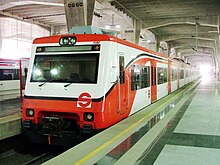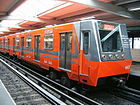Tren Suburbano: Difference between revisions
mNo edit summary |
|||
| Line 25: | Line 25: | ||
}} |
}} |
||
The '''Tren Suburbano''' ({{trans|literal=yes|Suburban Train}}){{efn|Official name: ''Ferrocarril Suburbano de la Zona Metropolitana del Valle de México'' (Suburban Railway of the Valley of Mexico Metropolitan Area)}} is an electric [[suburban rail]] system in [[Mexico City]]. It is operated by '''Ferrocarriles Suburbanos''' with [[Concession (contract)|concessioned]] trains from [[Construcciones y Auxiliar de Ferrocarriles]] (CAF). It was designed to complement the extensive [[Mexico City metro]] system, Latin America's largest and busiest urban rail network. |
The '''Tren Suburbano''' ({{trans|literal=yes|Suburban Train}}){{efn|Official name: ''Ferrocarril Suburbano de la Zona Metropolitana del Valle de México'' (Suburban Railway of the Valley of Mexico Metropolitan Area).}} is an electric [[suburban rail]] system in [[Mexico City]]. It is operated by '''Ferrocarriles Suburbanos''' with [[Concession (contract)|concessioned]] trains from [[Construcciones y Auxiliar de Ferrocarriles]] (CAF). It was designed to complement the extensive [[Mexico City metro]] system, Latin America's largest and busiest urban rail network. |
||
The railway has one operative line with a length of {{convert|27|km|mi|0|abbr=on}} with seven stations, located in [[Cuauhtémoc, Mexico City|Cuauhtémoc]] and [[Azcapotzalco]] in [[Mexico City]], and [[Tlalnepantla de Baz|Tlalnepantla]], [[Tultitlán de Mariano Escobedo|Tultitlán]] and [[Cuautitlán]], in the [[State of Mexico]]. A second line is expected to be built to connect with the [[Mexico City Santa Lucía Airport|Santa Lucía Airport]] in [[Zumpango]]. Additional expansions were proposed in the 2000s with a total length of {{convert|242|km|mi|0}} of rail system.<ref>{{cite web |url=http://dgtfm.sct.gob.mx/index.php?id%3D761 |title=Archived copy |access-date=2010-01-31 |url-status=dead |archive-url=https://web.archive.org/web/20090804035537/http://dgtfm.sct.gob.mx/index.php?id=761 |archive-date=2009-08-04 }}</ref> |
The railway has one operative line with a length of {{convert|27|km|mi|0|abbr=on}} with seven stations, located in [[Cuauhtémoc, Mexico City|Cuauhtémoc]] and [[Azcapotzalco]] in [[Mexico City]], and [[Tlalnepantla de Baz|Tlalnepantla]], [[Tultitlán de Mariano Escobedo|Tultitlán]] and [[Cuautitlán]], in the [[State of Mexico]]. A second line is expected to be built to connect with the [[Mexico City Santa Lucía Airport|Santa Lucía Airport]] in [[Zumpango]]. Additional expansions were proposed in the 2000s with a total length of {{convert|242|km|mi|0}} of rail system.<ref>{{cite web |url=http://dgtfm.sct.gob.mx/index.php?id%3D761 |title=Archived copy |access-date=2010-01-31 |url-status=dead |archive-url=https://web.archive.org/web/20090804035537/http://dgtfm.sct.gob.mx/index.php?id=761 |archive-date=2009-08-04 }}</ref> |
||
Revision as of 19:02, 3 August 2021
| Tren Suburbano | |||||||||||||||||||||||||||||||||||||||||||||||||||||||||||||||||||||||||||||||||||||||||||||||||||||||||||||||||||||||||||||||||||||||||||||||||||||||||||||||||||
|---|---|---|---|---|---|---|---|---|---|---|---|---|---|---|---|---|---|---|---|---|---|---|---|---|---|---|---|---|---|---|---|---|---|---|---|---|---|---|---|---|---|---|---|---|---|---|---|---|---|---|---|---|---|---|---|---|---|---|---|---|---|---|---|---|---|---|---|---|---|---|---|---|---|---|---|---|---|---|---|---|---|---|---|---|---|---|---|---|---|---|---|---|---|---|---|---|---|---|---|---|---|---|---|---|---|---|---|---|---|---|---|---|---|---|---|---|---|---|---|---|---|---|---|---|---|---|---|---|---|---|---|---|---|---|---|---|---|---|---|---|---|---|---|---|---|---|---|---|---|---|---|---|---|---|---|---|---|---|---|---|---|---|---|
 | |||||||||||||||||||||||||||||||||||||||||||||||||||||||||||||||||||||||||||||||||||||||||||||||||||||||||||||||||||||||||||||||||||||||||||||||||||||||||||||||||||
 | |||||||||||||||||||||||||||||||||||||||||||||||||||||||||||||||||||||||||||||||||||||||||||||||||||||||||||||||||||||||||||||||||||||||||||||||||||||||||||||||||||
| Overview | |||||||||||||||||||||||||||||||||||||||||||||||||||||||||||||||||||||||||||||||||||||||||||||||||||||||||||||||||||||||||||||||||||||||||||||||||||||||||||||||||||
| Locale | Mexico City and State of Mexico, Mexico | ||||||||||||||||||||||||||||||||||||||||||||||||||||||||||||||||||||||||||||||||||||||||||||||||||||||||||||||||||||||||||||||||||||||||||||||||||||||||||||||||||
| Transit type | Suburban rail | ||||||||||||||||||||||||||||||||||||||||||||||||||||||||||||||||||||||||||||||||||||||||||||||||||||||||||||||||||||||||||||||||||||||||||||||||||||||||||||||||||
| Number of lines | 1 | ||||||||||||||||||||||||||||||||||||||||||||||||||||||||||||||||||||||||||||||||||||||||||||||||||||||||||||||||||||||||||||||||||||||||||||||||||||||||||||||||||
| Number of stations | 7 | ||||||||||||||||||||||||||||||||||||||||||||||||||||||||||||||||||||||||||||||||||||||||||||||||||||||||||||||||||||||||||||||||||||||||||||||||||||||||||||||||||
| Daily ridership | 200,000 (2018)[1] | ||||||||||||||||||||||||||||||||||||||||||||||||||||||||||||||||||||||||||||||||||||||||||||||||||||||||||||||||||||||||||||||||||||||||||||||||||||||||||||||||||
| Headquarters | Mexico City | ||||||||||||||||||||||||||||||||||||||||||||||||||||||||||||||||||||||||||||||||||||||||||||||||||||||||||||||||||||||||||||||||||||||||||||||||||||||||||||||||||
| Website | Ferrocarriles Suburbanos | ||||||||||||||||||||||||||||||||||||||||||||||||||||||||||||||||||||||||||||||||||||||||||||||||||||||||||||||||||||||||||||||||||||||||||||||||||||||||||||||||||
| Operation | |||||||||||||||||||||||||||||||||||||||||||||||||||||||||||||||||||||||||||||||||||||||||||||||||||||||||||||||||||||||||||||||||||||||||||||||||||||||||||||||||||
| Began operation | June 2, 2008[2] | ||||||||||||||||||||||||||||||||||||||||||||||||||||||||||||||||||||||||||||||||||||||||||||||||||||||||||||||||||||||||||||||||||||||||||||||||||||||||||||||||||
| Operator(s) | Ferrocarriles Suburbanos, SA de CV | ||||||||||||||||||||||||||||||||||||||||||||||||||||||||||||||||||||||||||||||||||||||||||||||||||||||||||||||||||||||||||||||||||||||||||||||||||||||||||||||||||
| Reporting marks | S | ||||||||||||||||||||||||||||||||||||||||||||||||||||||||||||||||||||||||||||||||||||||||||||||||||||||||||||||||||||||||||||||||||||||||||||||||||||||||||||||||||
| Technical | |||||||||||||||||||||||||||||||||||||||||||||||||||||||||||||||||||||||||||||||||||||||||||||||||||||||||||||||||||||||||||||||||||||||||||||||||||||||||||||||||||
| System length | 27 km (16.78 mi)[3] | ||||||||||||||||||||||||||||||||||||||||||||||||||||||||||||||||||||||||||||||||||||||||||||||||||||||||||||||||||||||||||||||||||||||||||||||||||||||||||||||||||
| Track gauge | 1,435 mm (4 ft 8+1⁄2 in) | ||||||||||||||||||||||||||||||||||||||||||||||||||||||||||||||||||||||||||||||||||||||||||||||||||||||||||||||||||||||||||||||||||||||||||||||||||||||||||||||||||
| Electrification | 25 kV 60 Hz AC overhead lines[4] | ||||||||||||||||||||||||||||||||||||||||||||||||||||||||||||||||||||||||||||||||||||||||||||||||||||||||||||||||||||||||||||||||||||||||||||||||||||||||||||||||||
| |||||||||||||||||||||||||||||||||||||||||||||||||||||||||||||||||||||||||||||||||||||||||||||||||||||||||||||||||||||||||||||||||||||||||||||||||||||||||||||||||||
The Tren Suburbano (lit. transl. Suburban Train)[a] is an electric suburban rail system in Mexico City. It is operated by Ferrocarriles Suburbanos with concessioned trains from Construcciones y Auxiliar de Ferrocarriles (CAF). It was designed to complement the extensive Mexico City metro system, Latin America's largest and busiest urban rail network.
The railway has one operative line with a length of 27 km (17 mi) with seven stations, located in Cuauhtémoc and Azcapotzalco in Mexico City, and Tlalnepantla, Tultitlán and Cuautitlán, in the State of Mexico. A second line is expected to be built to connect with the Santa Lucía Airport in Zumpango. Additional expansions were proposed in the 2000s with a total length of 242 kilometres (150 mi) of rail system.[5]
History and description

Line 1 covers a route measuring 27 kilometres (17 mi) from Mexico City's Buenavista Station to the State of Mexico's Cuautitlán. The section, which began commercial service on June 2, 2008 (after three weeks of fare-free trial operation),[2] cost US$706 million to build, with the Mexican Federal Government contributing 55% of this investment. The inaugural demonstration trip of the service from Buenavista to Lechería Station and back again was made by then-President of Mexico, Felipe Calderón Hinojosa, and then-Governor of the State of Mexico (and eventual president of the country), Enrique Peña Nieto, with Calderón acting as the train's engineer.
Line 1 was built on an existing at-grade railroad right of way. However, inside Mexico City itself on the approach to Buenavista Station, a considerable amount of grade separation, including below-grade excavation and new bridges, was necessary due to high density and traffic congestion. The construction elicited complaints by Mexico City residents who objected to having their neighborhoods split by the rail line, but the public supported the project overall.
In addition to the track, the construction of Tren Suburbano also benefited from like-new electrification infrastructure already in place along most of the route, part of National Railways of Mexico (NdeM)'s Mexico City-Querétaro 25 kV 60 Hz mainline electrification completed in the 1990s but de-energized a few years later after NdeM was privatized.
On August 24, 2005, Construcciones y Auxiliar de Ferrocarriles, S.A. (CAF) obtained a 30-year concession to supply rolling stock, build and operate the Tren Suburbano.[6] The trains used on this service are electric trains built by CAF and are similar to the series 2000 trains of the Companhia Paulista de Trens Metropolitanos of São Paulo, Brazil.[7]
Service
Ridership
Line 1 was projected to carry 100 million passengers annually.[8] From the period of June 1, 2008 through July 7, 2008, the service carried one million passengers, or an average of approximately 30,000 passengers per day, which is a rate far below the annual projections.[9] As of January 31, 2010 according to the head of Comercialización y Administración de Riesgos del Ferrocarril Suburbano stated that Line 1 of the Suburban Railway of the Mexico City Metropolitan Area served an average of 88,000 passengers per day.[10] As of the end of 2012, ridership reached 132,000 per day, short of the 192,000 per day the private operator needed to stay solvent due to the high initial upfront cost and debt schedule. In 2012, the system ran an operational profit, but the profit was not high enough to cover accumulated debt repayment yet.[11] Ridership had increased to 184,000 per day as of 2015.[12] As of 2018, the Tren Suburbano had an average of 200,000 passengers per day.[1] Due to the COVID-19 pandemic in Mexico, ridership decreased 73% as of May 2020.[13]
Trains are scheduled every 6 minutes during peak hours.
Fare structure
As of 2021,[14] the fares are 9 pesos (approximately US$0.45) for a trip of three or fewer stations and 20 pesos (approximately US$1) for longer trips of four or more stations. Fares are paid using a rechargeable card that costs 20.00 pesos.[15]
Proposed expansions
Santa Lucía Airport–Lechería
Other

Authorities proposed to expand the system as far as it is practical to do so (the current long-range plan is for 242 kilometers of lines[16]), in order to reduce Mexico City's heavy road traffic congestion and air pollution. In most cases the system would follow existing rail lines; however, grade separations similar to the ones done on the initial segment may be necessary.
In December 2006, SCT announced that approval has been given for the 19.3 kilometres (12.0 mi) System 2, extending to Jardines de Morelos and Martín Carrera, and System 3 of an additional 12.8 km to Chalco and La Paz.[16][17][18][19]
| RAIL SYSTEM 1 | ||||||||||||||
| ROUTE | TYPE | LENGTH | ||||||||||||
|---|---|---|---|---|---|---|---|---|---|---|---|---|---|---|
| Buenavista-Cuautitlán | Main (built) | 27 kilometres (17 mi) | ||||||||||||
| Cuautitlán-Huehuetoca | Branch (not built) | 20 kilometres (12 mi) | ||||||||||||
| Lechería-Jaltocan | Branch | 20 kilometres (12 mi) | ||||||||||||
| San Rafael-Tacuba | Branch | 12 kilometres (7.5 mi) | ||||||||||||
| RAIL SYSTEM 2 | ||||||||||||||
| ROUTE | TYPE | LENGTH | ||||||||||||
|---|---|---|---|---|---|---|---|---|---|---|---|---|---|---|
| Martín Carrera-Jardines de Morelos | Main | 20 kilometres (12 mi) | ||||||||||||
| Martín Carrera-Tacuba | Branch | 12 kilometres (7.5 mi) | ||||||||||||
| Buenavista-Polanco | Branch | 8 kilometres (5.0 mi) | ||||||||||||
| Martín Carrera-Otumba | Branch | 28 kilometres (17 mi) | ||||||||||||
| Teotihuacan-Jaltocan | Branch | 22 kilometres (14 mi) | ||||||||||||
| RAIL SYSTEM 3 | ||||||||||||||
| ROUTE | TYPE | LENGTH | ||||||||||||
|---|---|---|---|---|---|---|---|---|---|---|---|---|---|---|
| Chalco-Nezahualcóyotl | Main | 31.82 kilometres (19.77 mi) | ||||||||||||
| Nezahualcóyotl-San Rafael | Branch | 22 kilometres (14 mi) | ||||||||||||
| La Paz-Texcoco | Branch | 21 kilometres (13 mi) | ||||||||||||
See also
- Buenavista metro station
- Buenavista railway station (old)
- Commuter rail in North America
- Ferrovalle
- List of suburban and commuter rail systems
- List of Mexican railroads
- Rail transport in Mexico
- Toluca–Mexico City commuter rail
Notes
- ^ Official name: Ferrocarril Suburbano de la Zona Metropolitana del Valle de México (Suburban Railway of the Valley of Mexico Metropolitan Area).
References
- ^ a b Juárez, Pilar (December 7, 2018). "Tren Suburbano alcanza viabilidad financiera". Milenio (in Spanish). Mexico City. Retrieved May 28, 2020.
- ^ a b "Alcanza Tren Suburbano 200 mil usuarios diarios". Railway Gazette International. December 6, 2018. Retrieved January 15, 2019.
- ^ "Suburbano La vía rápida al bienestar" [Suburban the fast way to well-being] (PDF) (in Spanish). Ferrocarriles Suburbanos [Suburban Railways]. Retrieved February 21, 2015.
- ^ "Espacio del Viajero: Conoce los Trenes" (in Spanish). Mexico City: Ferrocarriles Suburbanos. Retrieved May 24, 2011.
Alimentación (Vcc. catenaria): 25000, 60 Hz
- ^ "Archived copy". Archived from the original on August 4, 2009. Retrieved January 31, 2010.
{{cite web}}: CS1 maint: archived copy as title (link) - ^ "Archived copy" (PDF). Archived from the original (PDF) on April 20, 2006. Retrieved March 3, 2006.
{{cite web}}: CS1 maint: archived copy as title (link) - ^ "Frota de Trens". Companhia Paulista de Trens Metropolitanos. Archived from the original on May 1, 2008. Retrieved July 24, 2008.
- ^ "Operación: Estaciones Buenavista-Cuautitlán". Ferrocarriles Suburbanos. July 2, 2008. Retrieved July 24, 2008.
- ^ "El Suburbano rebasa el millón de usuarios". Ferrocarriles Suburbanos. July 2, 2008. Retrieved July 24, 2008.
- ^ "Concluyen en diciembre obras restantes del Tren Suburbano" (in Spanish). El Financiero: en línea. January 31, 2010. Archived from the original on December 7, 2018. Retrieved January 31, 2010.
- ^ "Archived copy". Archived from the original on January 1, 2013. Retrieved January 17, 2013.
{{cite web}}: CS1 maint: archived copy as title (link) - ^ "Archived copy". Archived from the original on January 15, 2016. Retrieved January 17, 2013.
{{cite web}}: CS1 maint: archived copy as title (link) El Universal. "Espera Suburbano mover a 52 millones" - ^ Morales, Amallely (May 11, 2020). "Baja 73% afluencia en Tren Suburbano". Reforma (in Spanish). Mexico City. Retrieved May 28, 2020.
- ^ "¡Prevente! Pasaje del Tren Suburbano subirá a partir de este domingo 18 de abril". El Financiero (in Spanish). April 16, 2021. Retrieved August 2, 2021.
- ^ "Operaciones: Costo del viaje". Ferrocarriles Suburbanos. Retrieved July 24, 2008.
- ^ a b Correo | Economía | Funcionaría en 2007 tren suburbano Archived January 6, 2007, at the Wayback Machine
- ^ Autorizan suburbano de La Paz a Chalco - El Universal - DF Archived June 17, 2013, at the Wayback Machine
- ^ Ferrocarriles Suburbanos - Noticias Archived September 28, 2007, at the Wayback Machine
- ^ Ferrocarril Urbano Archived April 8, 2008, at the Wayback Machine
External links
- Ferrocarril Suburbano – Official Site
- See definition on Ferropedia
- Renderings of railroad cars
- Official SCT video and details of the Ferrocarril Suburbano, in Spanish
- MEXLIST, the group for Mexican railway information
- "Estrenan Calderón y Peña Nieto el Tren Suburbano" (in Spanish). Archived from the original on June 5, 2011. Retrieved April 19, 2010.


